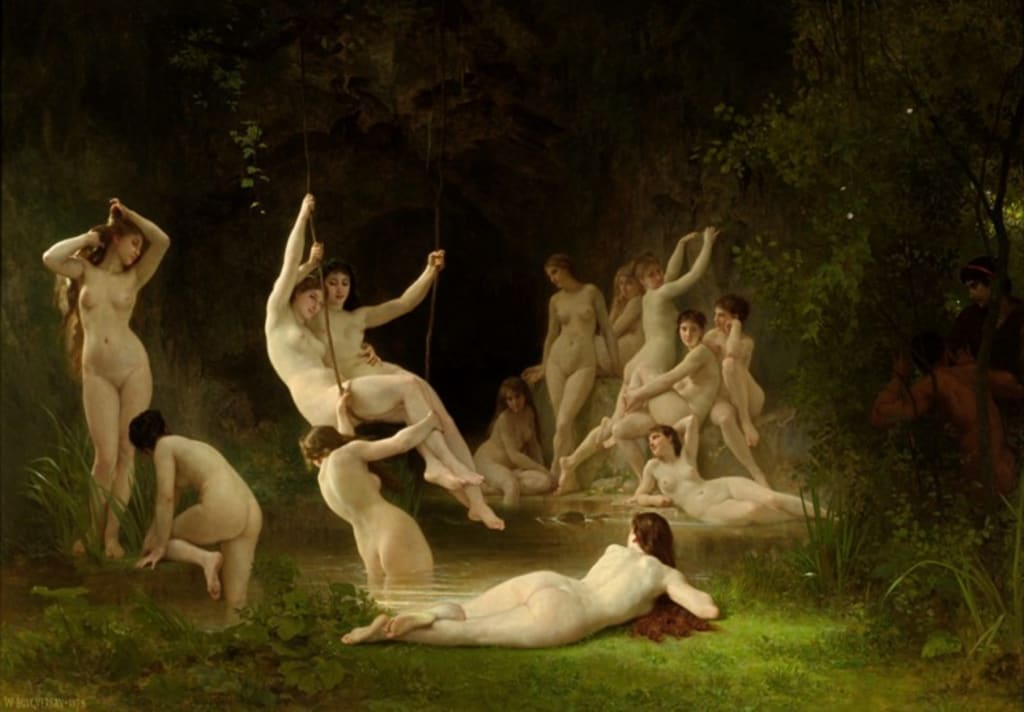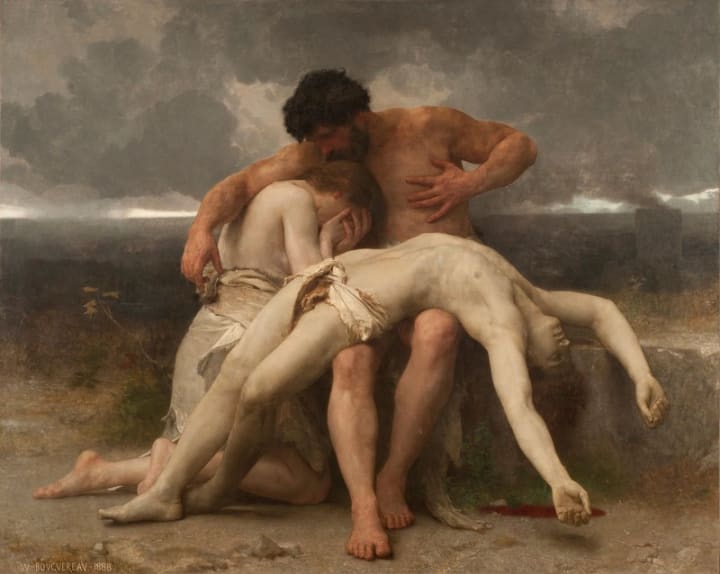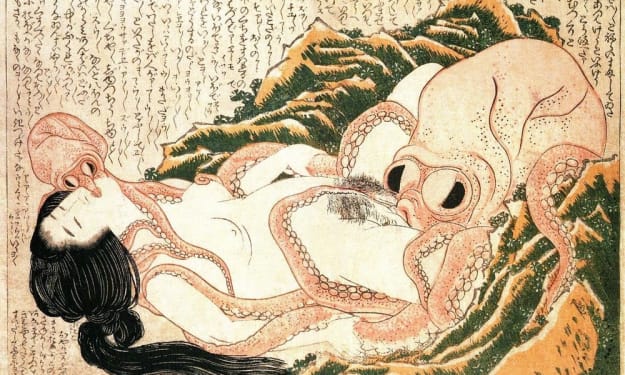Exploring Nudity, Nymphs and Feet Fetish
5 nudes by William Adolphe Bouguereau

Dante and Virgil became one of his most famous paintings and it personally attracted me to research Bouguereau's craft. Isn't this painting frighteningly beautiful?
However, when I delved into his other compositions, they seem to be photo idealistic. I extracted 5 of his nude paintings that revolve around the themes of mythology, history and legends.
Bouguereau often went leaps and bounds beyond pure visual realism - a kind of utopian worldview. The avant-garde artists accused Bouguereau of portraying the unrealistic view of the human form.
Degas and his friends used the term ''bouguerated'' to derogate a finicky, overly finished painting surface, and van Gogh put him down as a well- paid maker of ''soft, pretty things.''
Notice how he reused one of the nymphs in the 'Nymphaeum' to be the Venus in 'The Birth of Venus'. The slit between her calves, the sunkissed braids, and even the positioning of the little finger on her left hand are exactly the same. It's fascinating to see the replica and overlook the fact that there existed no 'copy-paste' during those times.
What do you think?

His portrayal of the female anatomy and the female figures look heavenly and immaculate. For me, the highlight of his paintings is the "realistic depiction of feet". Some, even go a step further and accuse him of having a 'feet fetish'.
1. The Nymphaeum (1878)
Do you wish to experience a serene daydream sight? Then, dive into The Nymphaeum.
The sunkissed and manicured bodies of nude women. Bouguereau rendered the figures in soft and luxurious texture.
The women are playing in the nymphaeum, which served as a sanctuary, or a reservoir and where weddings were held in ancient Greek periods. The women are carefree; while a satyr and a Greek man peep through the leaves.
Like them, we, the audience, are also peeping through this invisible wall that is the canvas.

The painting Nymphs and Satyr (1873) might have been the prequel to The Nymphaeum. The legend says that the Nymphs attract males to the water's edge in an effort to drown them. Look again how the Satyr is trying to pull back like a gazelle does when an alligator pounces.
2. The Abduction of Psyche (1895)

Perhaps, this is one of the favorite Greek myths for legend lovers - Psyche (worshipped as the incarnation of Venus) married Cupid after a complicated relationship.
Psyche is shrouded with soft purple transparent fabric. Bouguereau does not use the typical pink and red, often associated with young love. The wavy hair flow and the skin is silky soft.
Bouguereau chooses to paint Psyche with butterfly wings because 'psyche' was the Greek word given to butterflies by Aristotle.
In Bouguereau's levitational scene, it doesn't look like Psyche is abducted by Cupid. Rather, she holds a gratifying expression. The half-clad Psyche covers her breasts with eyes closed, travels across the mountainous landscape with Cupid.
3. The Birth of Venus (1879)

Doesn't this resemble Botticelli's The Birth of Venus?
Venus stands nude on the scallop shell. Cupid and Psyche, nymphs and centaurs gather to witness Venus's arrival. Two of the centaurs are blowing conch and Triton shells to welcome her.
The heavenly angels frolic in their own trance while everyone below Venus, idolizes her with their gaze. Cupid rides a black dolphin with reins in his hands while Psyche tries to restrain it.
Venus's immaculate naked body, elegant facial expressions and swaying to the right emphasizes the curves of her body.
Even for a painting with flying angels, he manages to ground his work heavily in reality, while at the same time being able to tap into a sort of mystical otherworldly sense.
4. The First Mourning (1888)

The French name of the painting is "Premier Deui" which translates to The First Mourning.
It portrays the moment after Adam and Eve found the body of their son Abel, who was murdered by Cain. This is the first human death documented in the Bible.
This artwork was painted after Bouguereau lost his second son.
The somber clouds overshadow the scene and set the mood for the painting. Adam seems to be drained while trying to console Eve who is suffering the deepest sorrow her heart can know. Bloodstains on the ground narrate the tragedy of betrayal and jealousy.
5. Dawn (1881)

A semi-naked woman with her beautiful feet. Can you take a moment to appreciate the reflection of her feet on the edge of the waters?
A similar portrayal of a shining naked body with the same posture is illustrated in his all other paintings.
Lastly
Critics find his work lacking in emotion, although present, a superficial tone. The melancholy of losing a young wife and four of his children is often subtle, never overdone.
As the tradition goes, his signature is placed in the lower-left corner on the front of the work.
Which is your favorite painting by Bouguereau? Do let me know in the comments.
References-
2. ART VIEW; TO BOUGUEREAU, ART WAS STRICKLY 'THE BEAUTIFUL'
Check my latest video on my Youtube channel.
About the Creator
Kamna Kirti
Art enthusiast. I engage with art at a deep level. I also share insights about entrepreneurship, founders & nascent technologies.
https://linktr.ee/kamnakirti






Comments (1)
"Premier Deui" or The First Mourning. Reminds me, in composition only, of Balthus' Guitar Lesson. Both are about the loss of innocence and in First Mourning the loss of life.